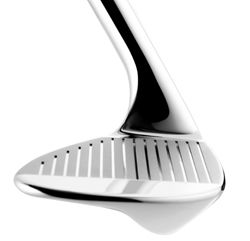
Grooves on a 60-degree CG12 wedge
|
Add wedges for greenside control
Cleveland carries out extensive research among club golfers when it designs it wedges and recently discovered that over five rounds, average handicappers (10-20) hit over 26% of their shots with a wedge of some description. Considering that these shots can be hit from bare lies, tightly-mown fairways, semi-rough, heavy rough and bunkers from anywhere between 10 and 120 yards from the pin, it's asking a lot of your pitching and sand wedge to accommodate all these different shots.
“Most pros carry at least three or four specialist wedges, while Phil Mickelson has been known to carry a five in his bag,” says Scott, who is responsible for working with players like Vijay Singh and David Howell in the creation of the latest range of Cleveland CG12 and CG14 wedges.
“Having so many lofts gives them a vast number of shot options around the green. And that's even more important for amateurs, who tend to miss greens more often than pros.”
Mind the gaps
Finding out where the distance gaps in your wedge set are is key to determining which clubs you need. Hitting half shots with any club is hard for even the best players, so Scott’s advice is to find clubs that you can hit full out from say 75, 95 and 120 yards from the flagstick, making sure that there are similar distance gaps between clubs. He also advises no greater gap than four degrees of loft between each wedge.
“The starting point for the wedge set is the pitching wedge(PW),” says Scott, “but because there is no industry standard loft, you could be playing with anything from 44 to 48 degrees. This can increase your yardage with one club by up to 30 yards, which is a massive amount for a short-range club.”

